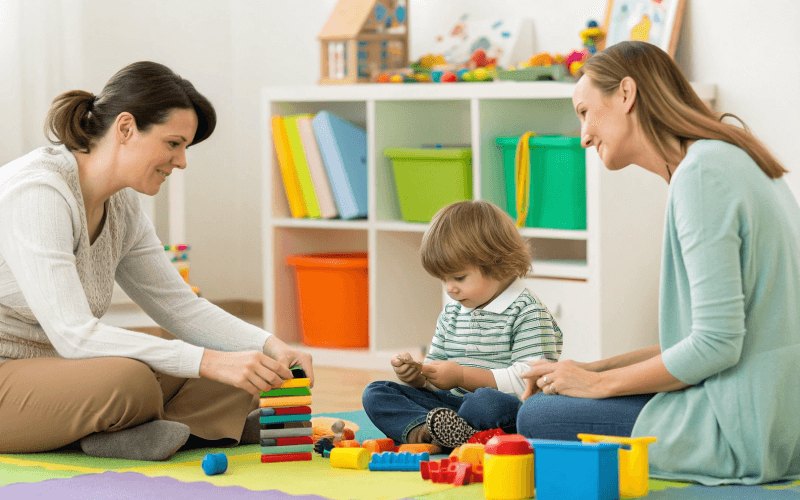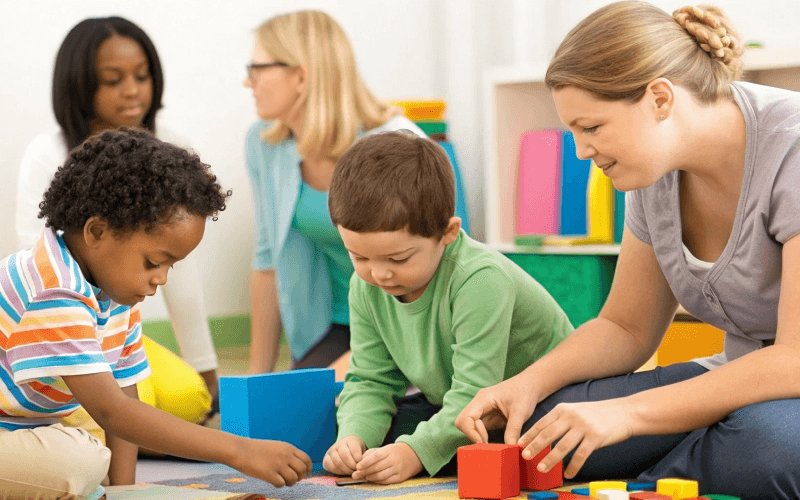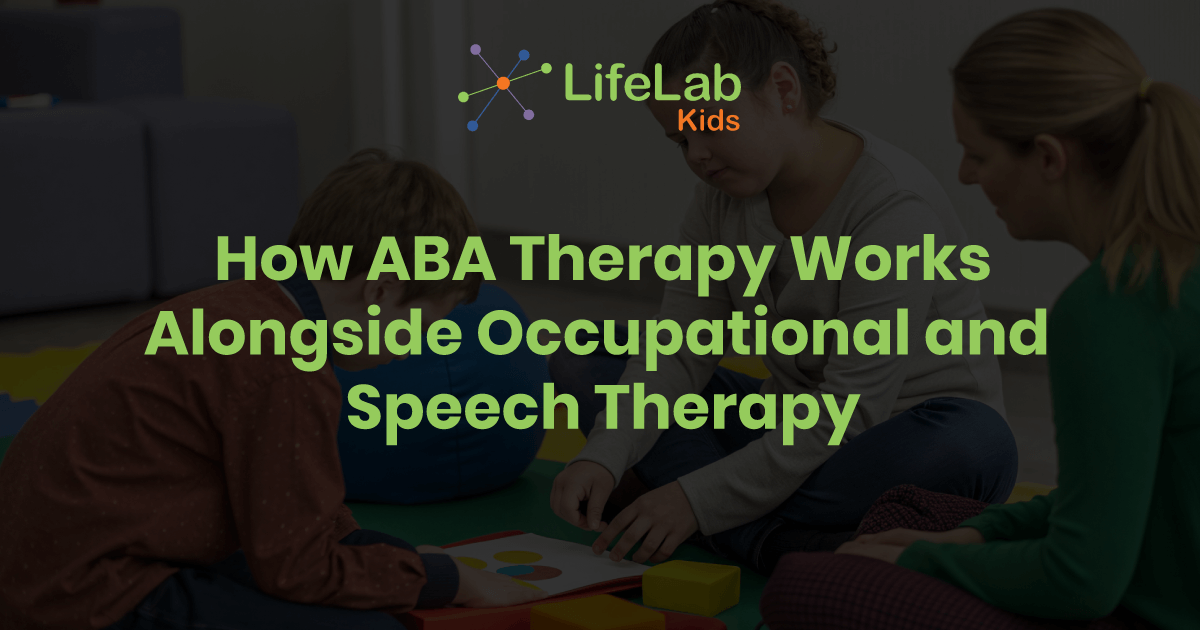Communication, movement, and daily life skills act as a building block for a neurodiverse child’s independence. Every gesture, word and small action carry meaning. For families witnessing a child’s growth, it is both inspiring and filled with hope. The journey may start with noticing small moments at home like a child reaching for a toy, attempting a new sound, or learning to button a shirt. These moments are filled with possibility, and the right support, which can turn into confidence, independence and joy.
ABA therapy, occupational therapy and speech therapy, each have their own focus, yet together they can develop an approach which nurtures a child’s development across multiple areas of life.

Understanding ABA Therapy: Guiding Communication Through Behavior
ABA therapy is described as a methodical approach to understand and encourage positive behavior. ABA is about observation, insights, and gentle guidance. Therapists notice the patterns in behavior, what motivates a child, how they respond to different environments, and how communication naturally comes in daily life.
Parents can use ABA strategies in action during simple routines, like mealtime, playtime, or getting dressed. For instance, a child who points out to a cup may receive a prompt to say the word “cup” before being handed the drink. Over time, these prompts can encourage natural communication attempts, reinforcing both the behavior and the verbal skill.
ABA therapy is not only about structure, but also about the connection. It provides a framework where children can feel encouraged to explore, experiment, and express themselves, knowing that their efforts are noticed and celebrated.
The Role of Speech Therapy: Building the Language of Expression
ABA provides behavioral guidance, while speech therapy focuses on the mechanics of language and expression. Speech therapists work on vocabulary, articulation, sentence structure, and conversational skills. They do exercises which turn communication into a joyful and engaging activity rather than a challenge.
Speech therapy adapts to the strengths and needs of each child. Some may thrive by using visual cues, others with auditory prompts, and many with a combination of both. The key is that every interaction becomes a chance to learn, practice, and succeed.

Occupational Therapy: Building Everyday Independence
While ABA therapy focuses on behavior, and speech therapy on language, occupational therapy (OT) helps neurodiverse children master daily life skills, fine and gross motor abilities, and sensory regulation. Occupational therapists guide in routines such as feeding, handwriting, dressing, and using utensils, while helping them navigate sensory challenges in a way which promotes confidence and independence.
Occupational therapy helps children engage with their environment comfortably and confidently. For example, a child learning to button a shirt is developing not only fine motor skills but also problem-solving abilities, patience, and self-assurance, skills that carry into all areas of life.
The Synergy: Integrating ABA, Speech, and Occupational Therapy
Great results are witnessed when ABA, speech, and occupational therapy work together for neurodiverse children. Each therapy acts in a certain way and informs the other, building a cohesive approach customized to a child’s strengths, preferences, and needs.
- ABA and Speech Therapy: ABA helps in identifying patterns and motivates attempts, while speech therapy provides the language to express needs, thoughts, and feelings. Think about a therapy session where a child makes use of picture cards to ask for their favorite snacks. The therapist models the word, the child repeats it, and the parents join in. Speech therapy makes these moments into skills that children may use independently, building confidence and sense of accomplishment.
- ABA and Occupational Therapy: ABA helps in understanding the daily routines, identifying opportunities for building life skills. Occupational therapy provides guidance and exercise to fine motor skills, sensory regulation, and practical independence. For example, ABA may help a child to try to button a shirt, while occupational therapy teaches the step-by-step skills to complete the task.
- All Three Together: In an integrated session, a child might practice stacking blocks while saying the word “stack” and following ABA-guided prompts. This approach ensures that communication, behavior, and functional skills are reinforced simultaneously, making learning meaningful, practical, and enjoyable.
A Journey of Small Wins
When a child pronounces a word correctly, completes a puzzle, or feeds themselves a meal, these moments may seem small to some—but they form the foundation for lifelong growth. Integrating these therapies lets autistic children experience success in multiple domains:
- Communication: Speaking words, forming sentences, using gestures to express needs.
- Motor Skills: Holding a pencil correctly, buttoning a shirt, using utensils.
- Behavioral Skills: Patience, following instructions, initiating interactions.
Each milestone helps in building confidence, encouraging curiosity, and fostering independence. Parents witness the growing joy and enthusiasm their children have for exploring new challenges.
Integrating Learning into Daily Life
ABA, speech, and occupational therapies extend beyond therapy rooms. They influence how neurodiverse children engage in everyday activities:
- Asking for breakfast at the table.
- Selecting a toy during playtime and expressing the choice verbally.
- Dressing independently for school or outings.
- Participating in group activities with peers.
The integration ensures that learning is continuous, natural, and part of the child’s daily routine. Parents become active participants, turning mealtime, playtime, and daily routines into opportunities for skill-building and positive reinforcement.
The Emotional Journey for Families
Families often share a moment of joy, pride, and wonder when they see a child’s progress in communication, independence and confidence. Merging ABA, speech, and occupational therapy lets parents feel guided and supported, providing the reassurance that each effort contributes to meaningful growth.
Parents also notice increased confidence in their child, better participation in home routines, and a growing sense of self-expression. This holistic support fosters stronger connections, both within the family and in broader social interactions.
The Lifelong Benefits of Integrated Therapy
By fostering communication early, families help the child with lifelong benefits:
- The children gain confidence to express themselves in social, academic, and home settings.
- Parents feel equipped to support ongoing growth, celebrate progress, and encourage independence.
- Everyday routines become opportunities for learning, making communication a natural part of life.
With consistent support and practices, a child develops the ability to extend beyond therapy sessions, positively influencing home life, school readiness, and social engagement.
Conclusion
At LifeLab Kids, families find an environment where ABA therapy, speech therapy, and occupational therapy work together to support neurodiverse children. Licensed therapists collaborate to design programs that respond to each child’s strengths and needs, ensuring progress across communication, motor skills, and behavioral development.
Parents are guided and empowered with practical strategies, turning everyday routines into meaningful learning opportunities. LifeLab Kids provides a holistic, supportive, and joyful space where children can explore, express, and grow, and families feel confident every step of the way.
With ABA, speech, and occupational therapy working together, every word spoken, every task mastered, and every milestone reached becomes part of a larger journey toward independence, confidence, and connection.

